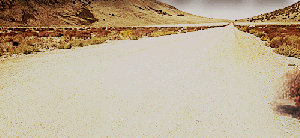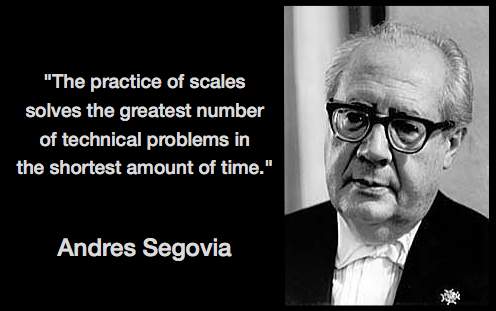It’s time to talk Guitar Technique.
Everyone who learns electric guitar will sooner or later encounter this exercise:

There are many possible variations on the basic idea, like these:


You might hear people refer to them to as warm up exercises, or the “Finger Gym” exercises, or “Technique” or “Speed Building” exercises.
I’m going to refer to them – all of them – as The 1234 Exercise. This is because the exercise and all the variations are combinations of the 1st, 2nd, 3rd, and 4th fingers in different patterns.
By using all four fingers in different combinations across a span of four frets, the idea is supposed to be that you develop your guitar technique more quickly by ‘working out’ with the 1234 exercise.
Sounds pretty good in theory, doesn’t it?
The truth is these exercises suck, and you shouldn’t waste any practice time on them.
So, what’s the problem? A few things, but let’s start with the most obvious:
They sound like shit
The first thing that immediately strikes you about all of these exercises is how incredibly BAD they sound.
The reason they sound so bad is because they’re just numerical combinations of fingers — there’s no musical relationship between the notes you’re playing.
It’s an effort just to force yourself to sit and practice these exercises, and no matter how much you practice them or how fast you get, they will never sound good.
Not only is this no fun for you, spare a thought for anyone else within earshot who is hearing your practice.
Hitting these exercises every day is a surefire way to ensure your wife or girlfriend will hate it when you practice guitar! Not cool.
But perhaps you’re thinking it might be worth spending time on some uninspiring sounding exercises (and annoying everyone you live with), if it meant eventually being able to play guitar how you want?
Sure… I like your attitude, and I might agree – IF these exercises actually made you a better player. But they don’t.
Let’s explore why that is.
You don't use these patterns in any real music
When was the last time you were learning a song or solo and encountered a part that went 1234 from the low E string up to the top E string…? Or 2431 from the D to B strings…? Or 1432, ascending fret by fret up the A string…?
Hmm?

… … …
That’s right.
The patterns are finger patterns – not musical patterns – and that’s why we don’t see them in real music.
“But it’s just an exercise for practice. Exercises don’t need to sound good.”
Wrong (and you’ll see why in the next section).
Time is limited, and no matter who you are or what you do, you have only so much time available in the day to practice guitar.
Whether you have 30 minutes or 3 hours a day to practice, the worst thing you can do is to invest your time in things which there’s no way you will never use in real playing.
Guitar Practice is a big topic, but two key ideas are Efficiency and Effectiveness.
Efficiency means getting a lot done in relation to the time you spend practicing, and Effectiveness means practicing the things that actually produce results.
1234 exercises violate both principles – they’re inefficient because they take up time that could be far better spent, and they’re ineffective because no matter how much you practice them, you can’t actually use them.
And this gets to the root of the problem…
The core idea of the 1234 exercise is wrong
Let’s clearly define what we’re actually trying to accomplish by practicing guitar technique.
Technique is the level of physical freedom you have to command an instrument.
And since the guitar is a musical instrument, ‘freedom’ means the freedom to play music.
It could be music that already exists out there that you want to learn and play yourself, or it could be musical ideas in your head which you want to express and make real…
Whatever you want to do, guitar technique is the wall between yourself and being able to physically play anything you could imagine or desire.
Once it’s laid out like this, you can see that working on guitar technique has a very clear purpose:
Being able to play the music that you want to play.
And that’s why 1234 exercises are completely missing the point.
Guitar technique can’t be developed in isolation – by using deliberately unmusical patterns that don’t appear in real music – and then applied to music. That doesn’t make sense.
If this seems overly complicated, it’s as simple as this:
Shitty sounding unrealistic exercises won’t equip you with the skills to play awesome guitar in real life.
So, what should you use instead to develop your technique? I’ll give you a hint.
You need to use the same elements that music is already made from…
SCALES

A lot of people run a mile the second the word “Scales” is mentioned, but they really shouldn’t.
Sometimes people are led to believe that scales are ‘boring’ or ‘hard’, but that’s definitely not the case, and there is nothing to be afraid of.
A scale is just a pre-organised group of notes that are known to sound good together, and which lend themselves to a particular musical mood or emotion.
As a guitar player, this is not something to avoid — this is EXACTLY what you want to master.
Every song ever written uses one or more scales, because scales are the building blocks of all melodies and chord progressions.
Scales are like the blueprints to music, so you’re always using them… even if you don’t realise you are!
This is why scales are the most perfect tool there could be to develop your guitar technique.
The scales used in popular music already contain every possible combination of notes and fingerings that you could ever use, so you can use them to work on any and every aspect of guitar technique
The magic of scales
Let me give you a really quick example using just one extremely popular scale – the Natural Minor. Here is a common lead guitar pattern for that scale:

Just to play this up and down, you can see the workout your left and right hands will get, as there are various different fingerings and movements involved. You can also practice it with different picking patterns, and with techniques like hammer ons, pull offs and slides.
Once you can do some of that, the next step is to make things progressively harder, creating ever more challenging exercises out of the scale. One of the many things you could do is play the notes in a sequence like this:

Or like this:

Or if I want to work on playing along the string rather than across strings, I can work on the scale along one string in a cool sequence like this:

That could be used in a solo! All of them could be. You see? You’re practicing your technique, but you’re doing it musically.
So many variations are possible (seriously…), and the exercises you can create are directly linked to what really happens in music. It’s like really realistic training for playing guitar.
This is why when musicians talk “practicing scales”, it means a lot more than boring up-and-down repetition like many people might imagine.
This is a very brief glimpse into what “pro” guitar practice using scales looks like.
It’s where Practice and Music are one.
And, unlike the artificial 1234 exercises, when you practice using scales, you are developing the skills you really need and will actually use when playing real music.
When you have practiced a scale and you learn a song that uses that same scale, you’re already ten miles ahead. It feels so familiar and logical, even if you’ve never played that song before, and you can learn and be able to play real music so much faster (and remember it better too).
What’s more, they actually sound good to practice — because they use the real musical structures that already appear in music!
Do you see what I’m saying?
There’s no reason to practice non-musical exercises, because scales are already right there and they are already the most perfect exercise there could possibly be.
Let’s be real guys — If you’ve already been playing guitar for several years then I can’t be the first person to tell you that scales are really important.
Chances are that you’ve probably heard this message before, but you’ve ignored it.
You wouldn’t be the first person to try to bypass actually learning things properly or ‘formally’ – I did all the same things when I was learning to play.
Everyone likes the idea that there is a special exercise that can give you the technique of a guitar god without learning anything of any substance.
There IS a shortcut to being good, but it’s called – as it always has been and will be – “doing things properly”.
The 1234 exercise is a waste of time and a false shortcut — it takes you miles off course and costs you far more time and energy than if you just go the correct route.
It’s time to ditch the bullshit exercises and get on board with doing things the right way — you won’t regret it.
– Christy